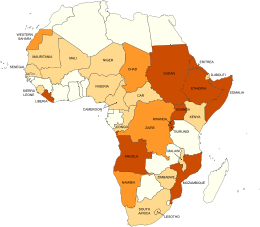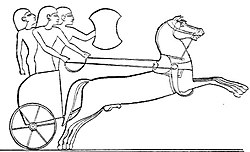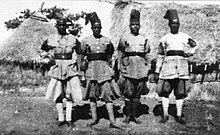Military history of Africa
The military history of Africa is one of the oldest military histories in the world. Africa is a continent of many regions with diverse populations speaking hundreds of different languages and practicing an array of cultures and religions. These differences have also been the source of much conflict since a millennia.
Like the history of Africa, military history on the continent is often divided by region. North Africa was part of the Mediterranean cultures and was integral to the military history of classical antiquity, and East Africa has historically had various states which have often warred with some the world's most powerful. The military history of modern Africa may be divided into three broad time periods: pre-colonial, colonial, and post-colonial.[1]
Antiquity
Ancient Egyptian and Nubian military history
In 3100 BC,
The revitalized Egyptians expanded north and east into
.The gradual disintegration in the Twentieth Dynasty allowed the founding of the Kushite kingdoms of Nubia, centered on Napata. Kush reached a height under Piye, who conquered Egypt and founded the Twenty-fifth Dynasty. However, the Kushites were gradually driven back to Napata by an Assyrian invasion and then the resistance of the Twenty-sixth Dynasty kings.
Ancient Aksumite military history
This section needs expansion. You can help by adding to it. (January 2014) |
The
Military history of modern Africa
Adal-Ethiopian wars
While
Ajuran-Portuguese wars


The

Over the next several decades Somali-
The Somali-Ottoman offensive managed to drive out the Portuguese from several important cities such as Pate, Mombasa and Kilwa. However, the Portuguese governor sent envoys to Portuguese India requesting a large Portuguese fleet. This request was answered and it reversed the previous offensive of the Muslims into one of defense. The Portuguese armada managed to re-take most of the lost cities and began punishing their leaders, but they refrained from attacking Mogadishu, securing the city's autonomy in the Indian Ocean.[11][12] Ajuran's Somali forces would eventually militarily defeat the Portuguese. The Ottoman Empire would also remain an economic partner of the Somalis.[13] Throughout the 16th and 17th centuries successive Somali Sultans defied the Portuguese economic monopoly in the Indian Ocean by employing a new coinage which followed the Ottoman pattern, thus proclaiming an attitude of economic independence in regard to the Portuguese.[14]
Independence struggles
Starting in the 1950s, anti-colonial movements agitated for independence from the colonial powers. This agitation, coupled with an international system that was increasingly hostile to colonialism, led killed to a process of decolonization that was often violent.
The first successful anti-colonial armed struggle in Africa was the
Other example of successful armed resistance is the Portuguese Colonial War (1961–1974), which led to the independence of Angola, Guinea-Bissau and Mozambique.[15] The Rhodesian Bush War (1966–1979) was not against a colonial metropole, but the minority white government of Ian Smith.
These national liberation movements were informed by the successful guerrilla warfare doctrine used in the Indonesian National Revolution (1945–1949) and the First Indochina War (1946–1954). The insurgents' goal was thus not to win the war — and no colonial army was ever defeated — but simply not to lose, thus making the conduct of the war unbearable for the colonial power over the long term.

The writings of Frantz Fanon on the Algerian conflict became hugely influential on later African conflicts. These conflicts benefited from internal ideological and organizational cohesion, sympathetic diplomatic backing in global forums, some financial backing (in particular from the Nordic states) and military training and supplies from the Soviet bloc.[15]
Two national liberation movements that became violent and were unsuccessful in that they did not lead to de facto capitulation and independence were the
There have been two liberation movements against an African power over the borders drawn during the colonial period. The Polisario Front began a struggle in 1973 for the independence of Western Sahara against Spain and then Morocco, when the North African country invaded.
In Eritrea, the Eritrean Liberation Front and later Eritrean People's Liberation Front carried out an independence struggle against Ethiopia that culminated successfully in 1991.
In two special cases, and in contrast to these bloody wars, both
Post-colonial

African nations have made great efforts to respect international borders as inviolate for a long time. For example, the
The boundary marking a civil war is blurred in Africa as many civil wars involved foreign backers if not active belligerents. Libya's actively intervened into Chad with air forces, and France retaliated with support for the other side. Sudan experienced a prolonged civil war, resulting in the separation of South Sudan as an independent state. Similar to South Sudan, Eritrea won independence from Ethiopia. Congo's civil war involved seven states, among them Zimbabwe, Rwanda, and Uganda. Eritrea is under United Sanctions for its alleged support role in the civil conflict in southern Somalia. Sierra Leone's civil war was ended with the restoration of ousted civilian government by British and Nigerian forces. Angola's civil war involved Cuban, American and Chinese backing for differing groups.
Military history of Africa by regions
Military history of Northern Africa
- See List of conflicts in the Maghreb, History of North Africa, History of the Mediterranean region.

North Africa and Southern Europe face each other across the Mediterranean Sea. Most of the southern areas of North Africa are cut off by the vast inhospitable Sahara desert. Therefore, the coastal areas have many resources to support the needs of large armies and the moderate-to-hot climate makes the movement of forces across vast stretches of land very feasible. North Africa has been the source of both cultural and economic interactions as well as military rivalries that became famous wars in history.
Egypt is located in Africa, and the Ancient Egyptian Empire was noted for its use of massed horse-drawn chariots in warfare, as well as fighting against invading empires from Babylonia, Assyria, and the Persian Empire.
Ancient Greece and the armies of Alexander the Great (336 BC–323 BC) invaded and conquered some parts of North Africa and his generals set up the Ptolemaic dynasty in Egypt. The armies of the Roman Republic (509 BC–31 BC) and the Roman Empire (31 BC–AD 476) subsequently conquered the entire coastal areas of North Africa. The people of Carthage fought the bloody and lengthy Punic Wars (264 BC–146 BC) against Rome.
Each century has seen the invasion of North Africa by various peoples, empires, nations and religions, and each in turn yielded its wars and conflicts.

Beginning in the 7th century, the military victories of the
Attacks by the
The arrival of modern
When modern Islamic countries gained their independence in North Africa, often following serious warfare (such as during the
, which finally led to strategic and political gains for Egypt and Israel.Military history of the Horn Africa

The
Countries and areas with ancient histories, such as
Somalia's many
Ethiopian soldiers decisively defeated the Italians at the
In the later part of the 20th century, several wars were waged in the region, including the
Military history of East Africa
In 1885,
In the 20th century, a number of groups engaged in
Recent
Military history of Central Africa
See: Central Africa. Central Africa, at times also called Middle Africa, is almost entirely landlocked; it lies astride the equator with heavy rainforest jungles and is rich in minerals and natural products. In ancient times there had been a Kingdom of Kongo which confronted invasions from explorers and settlers from Portugal starting in the 15th century.
The harsh colonial era of the Belgian Congo (1908–1960) gave way to the Congo Crisis (1960–1965) that brought in UN peacekeepers, particularly after the mineral-rich Katanga Province failed to secede in 1960, even though it had the support of Belgian business interests and over 6000 Belgian troops.
Subsequent conflicts in the Congo were the
The

The Arabs and Islamic powers have had an historical impact, as in the history of the Central African Republic, the trans-Saharan slave trade was forcibly imposed upon the people of Central Africa.
The colonial powers, particularly Belgium and France, were dominant during the 18th and 19th centuries.
There have been a number of civil wars and genocides in Central Africa that are also close to East Africa, such as the
Military history of Western Africa
During the colonial era, the powers of Europe sought to carve new colonies for themselves. This was made possible geographically because West Africa's coast is on the Atlantic Ocean, making it both open to cultural and trade influences, as well as to conquest by sea. West Africa is rich in many precious metals, minerals and products, which invites the interest and competition of outside powers and influences. There were some bloody conflicts in the 20th century when some of these nations fought against the colonial powers, such as during the Guinea-Bissau War of Independence (1963–1974).
During the centuries, several African countries experienced bitter
Military history of Southern Africa
Southern Africa, like the other main regions of Africa, is a complex region. It has numerous land-locked countries, but it is most notable in that it is surrounded by both the Atlantic Ocean to the west and the Indian Ocean to the east.
It is in this context that the position of the Cape of Good Hope, South Africa, and Southern Africa as a whole should be appreciated, because in the Southern Hemisphere, only South Africa, the southern end of South America, and Australia have this key strategic position.
In addition, from Europe — and also from the east coasts of the United States and South America (Brazil, Argentina), the route around South Africa's Cape is the shortest to Asia.
The Suez Canal did not exist for most of history. It was only completed in 1869, so that all shipping back and forth from Europe to Asia, Arabia, and to most of Africa had and has to be done by the long routes across the seas around South Africa's Cape.
Even after the Suez Canal's completion and modernization, it cannot accommodate larger vessels including many warships, tankers, and cargo vessels. Thus the Cape of Good Hope route remains one of the most important and highly desirable routes for free shipping when some of the world's other global choke points are closed off or in a state of war.

Wealthy nations are usually great maritime naval powers, and the use of navies is tied in with protecting those great nations' trade and their military strength, both of which result in geostrategic strength. Essentially, the power that has the mightiest navy and prevails on the high seas becomes the world's greatest power, which is something nations have known for a long time, hence their commercial and naval rivalry on the high seas.
In the
The
The most notable wars and conflicts in Southern Africa were those between the colonial powers of Europe who fought to dominate and control the African people of Southern Africa as well as the wars between the British and the white
The Dutch fought the
During the
There was also an inter-African conflict during the
The British fought and were defeated by the Boers during the
South Africa also contributed heavily to the Allied war effort during
- The South African Army and invaded Ethiopiain 1935.
- Another important victory that the South Africans participated in was the liberation of Malagasy (now known as Madagascar) from the control of Vichy France. British troops aided by South African soldiers staged their attack from South Africa and occupied the strategic island in 1942 to preclude its seizure by the Japanese.
- The South African 1st Infantry Division took part in several actions in North Africa in 1941 and 1942, including the Battle of El Alamein, before being withdrawn to South Africa.
- The South African 2nd Infantry Division also took part in a number of actions in North Africa during 1942, but on 21 June 1942 two complete infantry brigades of the division, as well as most of the supporting units, were captured at the fall of Tobruk.
- The South African 3rd Infantry Divisionnever took an active part in any battles, but instead organised and trained the South African home defence forces, performed garrison duties, and supplied replacements for the South African 1st Infantry Division and the South African 2nd Infantry Division. However, one of this division's constituent brigades, 7 SA Motorised Brigade, did take part in the invasion of Malagasy.
- The South African 6th Armoured Division, which incorporated many Southern Rhodesian volunteers, fought in numerous actions in Italyfrom 1944 to 1945.
- South Africa contributed to the war effort against Japan, supplying men and manning ships in naval engagements against the Japanese.[22]

Altogether, 334,000 men volunteered for full-time service in the South African Army during WWII, including some 211,000 whites, 77,000 blacks and 46,000 "coloureds" and Asians), with nearly 9,000 killed in action.
Modern conflicts involving South Africa's predominantly Afrikaner government raged as a result of its controversial
An Angolan War of Independence (1961–1974), part of a broader Portuguese Colonial War in Africa, was followed by the Angolan Civil War (1974–2002). Similarly, the Mozambican War of Independence (1964–1974) was followed by the Mozambican Civil War (1975–1992). The Rhodesian Bush War (1966–1979) saw the conservative white minority government in Rhodesia (Zimbabwe) toppled by nationalist guerrillas.
The South African Defence Force built nuclear weapons and is alleged to have tested one off its coast (facing the South Pole near Antarctica) as part of what has become known as the Vela incident. As of 2014, no other African country has obtained nuclear weapons of any description.
See also
- List of conflicts in Africa
- List of African Union military interventions
- African theatre of World War I
- African military systems to 1800
- African military systems (1800–1900)
Notes and references
- ^ For modern Africa see Kelechi A. Kalu, ed. Civil Wars in Africa (2022) excerpt
- ^ Saheed A. Adejumobi, The History of Ethiopia, (Greenwood Press: 2006), p.178
- ^ Encyclopædia Britannica, inc, Encyclopædia Britannica, Volume 1, (Encyclopædia Britannica: 2005), p.163
- ^ John L. Esposito, editor, The Oxford History of Islam, (Oxford University Press: 2000), p. 501
- ^ Maritime Discovery: A History of Nautical Exploration from the Earliest Times pg 198
- ^ The History of the Portuguese, During the Reign of Emmanuel pg.287
- ^ The book of Duarte Barbosa – Page 30
- ^ Tanzania notes and records: the journal of the Tanzania Society pg 76
- ^ The Portuguese period in East Africa – Page 112
- ISBN 9780842615884.
- ISBN 978-1-57607-919-5.
- ^ Four centuries of Swahili verse: a literary history and anthology – Page 11
- ISBN 978-1-61069-106-2.
- ^ COINS FROM MOGADISHU, c. 1300 to c. 1700 by G. S. P. Freeman-Grenville pg 36
- ^ a b c Crawford Young, "Contextualizing Congo Conflicts: Order and Disorder in Postcolonial Africa" in John F. Clark, ed., The African Stakes of the Congo War, Palgrave MacMillan: New York, 2002, p. 15
- ^ Kodjo, Tchioffo. "OAU Charter, Addis Ababa, 25 May 1963-African Union – Peace and Security Department". African Union, Peace and Security Department.
- S2CID 153804691.
- ^ The Economist, March 28th 2020, page 7, "The forever wars".
- ^ Oliver Ramsbotham, Tom Woodhouse, Encyclopedia of international peacekeeping operations, (ABC-CLIO: 1999), p.222.
- ISBN 979-10-365-2378-6, retrieved 2023-11-17
- ISBN 978-2-35926-047-2.
- ^ "South Africa and the War against Japan 1941–1945". South African Military History Society (Military History Journal – Vol 10 No 3). November 21, 2006.
Further reading
- Kalu, Kelechi A. ed. Civil Wars in Africa (2022) excerpt
